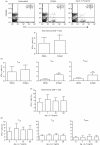Interleukin-7 enhances memory CD8(+) T-cell recall responses in health but its activity is impaired in human immunodeficiency virus infection
- PMID: 20673240
- PMCID: PMC2999803
- DOI: 10.1111/j.1365-2567.2010.03325.x
Interleukin-7 enhances memory CD8(+) T-cell recall responses in health but its activity is impaired in human immunodeficiency virus infection
Abstract
Memory CD8(+) T cells regain function during a recall response, but the requirement of signals in addition to antigen during a secondary immune response is unknown. In this study, the ability of interleukin-7 (IL-7) to enhance memory CD8(+ ) CD45RA(- ) CD127(+) T-cell responses in health and in human immunodeficiency virus (HIV) infection was investigated. CD8(+) T-cell-depleted peripheral blood mononuclear cells (PBMCs) from HIV(-) and untreated HIV(+) donors were pulsed with a cytomegalovirus/Epstein-Barr virus/influenza (CEF) peptide pool, and co-cultured with autologous memory CD8(+) T cells in the presence of IL-7. Cell survival and the function of memory CD8(+) T-cell subsets were then evaluated. Memory CD8(+) T-cell proliferation and interferon-γ (IFN-γ) production was enhanced by the presence of antigen, and the addition of IL-7 further enhanced antigen-induced proliferation. In HIV(+) individuals, the presence of antigen enhanced IFN-γ production to a small degree but did not enhance proliferation. Lastly, IL-7 did not enhance antigen-mediated proliferation of memory CD8(+) T cells from HIV(+) individuals. IL-7 therefore appears to have a role in secondary immune responses and its activity is impaired in memory CD8(+) T cells from HIV(+) individuals. These results further our understanding of the signals involved in secondary immune responses, and provide new insight into the loss of CD8(+) T-cell function in HIV infection.
© 2010 The Authors. Immunology © 2010 Blackwell Publishing Ltd.
Figures





Similar articles
-
CD8+ T cells from most HIV-1-infected patients, even when challenged with mature dendritic cells, lack functional recall memory to HIV gag but not other viruses.Eur J Immunol. 2005 Jan;35(1):159-70. doi: 10.1002/eji.200425744. Eur J Immunol. 2005. PMID: 15580653
-
CD127 expression and regulation are altered in the memory CD8 T cells of HIV-infected patients--reversal by highly active anti-retroviral therapy (HAART).Clin Exp Immunol. 2006 Mar;143(3):398-403. doi: 10.1111/j.1365-2249.2006.03022.x. Clin Exp Immunol. 2006. PMID: 16487237 Free PMC article.
-
HIV-1-specific IFN-gamma/IL-2-secreting CD8 T cells support CD4-independent proliferation of HIV-1-specific CD8 T cells.Proc Natl Acad Sci U S A. 2005 May 17;102(20):7239-44. doi: 10.1073/pnas.0502393102. Epub 2005 May 4. Proc Natl Acad Sci U S A. 2005. PMID: 15872023 Free PMC article.
-
Acquired transcriptional programming in functional and exhausted virus-specific CD8 T cells.Curr Opin HIV AIDS. 2012 Jan;7(1):50-7. doi: 10.1097/COH.0b013e32834ddcf2. Curr Opin HIV AIDS. 2012. PMID: 22134341 Free PMC article. Review.
-
Signals for antigen-independent differentiation of memory CD8+ T cells.Cell Mol Life Sci. 2021 Oct;78(19-20):6395-6408. doi: 10.1007/s00018-021-03912-9. Epub 2021 Aug 16. Cell Mol Life Sci. 2021. PMID: 34398252 Free PMC article. Review.
Cited by
-
Association between the IL7R T244I polymorphism and multiple sclerosis risk: a meta analysis.Neurol Sci. 2016 Sep;37(9):1467-74. doi: 10.1007/s10072-016-2608-8. Epub 2016 May 17. Neurol Sci. 2016. PMID: 27188999
-
The Association of IL7R rs6897932 with Risk of Multiple Sclerosis in Southern Chinese.Neuropsychiatr Dis Treat. 2022 Aug 26;18:1855-1859. doi: 10.2147/NDT.S376066. eCollection 2022. Neuropsychiatr Dis Treat. 2022. PMID: 36052273 Free PMC article.
-
The effect of human immunodeficiency virus-1 on monocyte-derived dendritic cell maturation and function.Clin Exp Immunol. 2012 Oct;170(1):101-13. doi: 10.1111/j.1365-2249.2012.04628.x. Clin Exp Immunol. 2012. PMID: 22943206 Free PMC article.
-
Mathematical model reveals how regulating the three phases of T-cell response could counteract immune evasion.Immunology. 2015 Oct;146(2):271-80. doi: 10.1111/imm.12500. Epub 2015 Aug 2. Immunology. 2015. PMID: 26119966 Free PMC article.
-
Major influence of CD4 count at the initiation of cART on viral and immunological reservoir constitution in HIV-1 infected patients.Retrovirology. 2016 Jun 30;13(1):44. doi: 10.1186/s12977-016-0278-5. Retrovirology. 2016. PMID: 27363286 Free PMC article.
References
-
- Sallusto F, Lenig D, Forster R, Lipp M, Lanzavecchia A. Two subsets of memory T lymphocytes with distinct homing potentials and effector functions. Nature. 1999;401:708–12. - PubMed
-
- Wherry EJ, Teichgraber V, Becker TC, Masopust D, Kaech SM, Antia R, von Andrian UH, Ahmed R. Lineage relationship and protective immunity of memory CD8 T cell subsets. Nat Immunol. 2003;4:225–34. - PubMed
-
- Chang JT, Palanivel VR, Kinjyo I, et al. Asymmetric T lymphocyte division in the initiation of adaptive immune responses. Science. 2007;315:1687–91. - PubMed
-
- Stemberger C, Huster KM, Koffler M, Anderl F, Schiemann M, Wagner H, Busch DH. A single naive CD8+ T cell precursor can develop into diverse effector and memory subsets. Immunity. 2007;27:985–97. - PubMed
-
- Lefrancois L. Development, trafficking, and function of memory T-cell subsets. Immunol Rev. 2006;211:93–103. - PubMed
Publication types
MeSH terms
Substances
LinkOut - more resources
Full Text Sources
Medical
Research Materials

